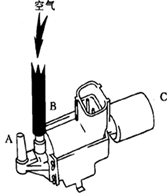问题
问答题
发电站需向远距离负载供电,若发电机输出电压U1=230V,输出功率
P1=2.3×105W,负载额定电压U4=220V,输电线总电阻R0=1Ω要求输电线损失功率为1.0×104W求:
(1)输电线电流I2大小;
(2)升压变压器原、副线圈匝数比;
(3)降压变压器原、副线圈匝数比.

答案
(1)由P损=
R得:I2=I 22
=P损 R0
=100A1.0×104 1
(2)升压变压器副线圈电压:U2=
=P1 I2
=2300V2.3×105 100
根据变压比公式,有:
=n1 n2
=U1 U2
=230 2300 1 10
(3)降压变压器的输入电压为:U3=U2-U损=U2-I2R0=2300-100×1=2200V
根据变压比公式,有:
=n3 n4
=U3 U4
=2200 220 10 1
答:(1)输电线电流I2大小为100A;
(2)升压变压器原、副线圈匝数比为1:10;
(3)降压变压器原、副线圈匝数比10:1.

